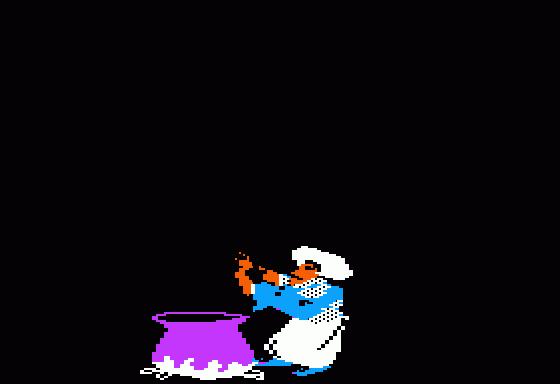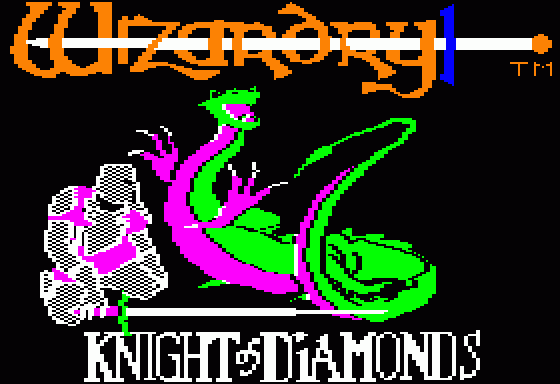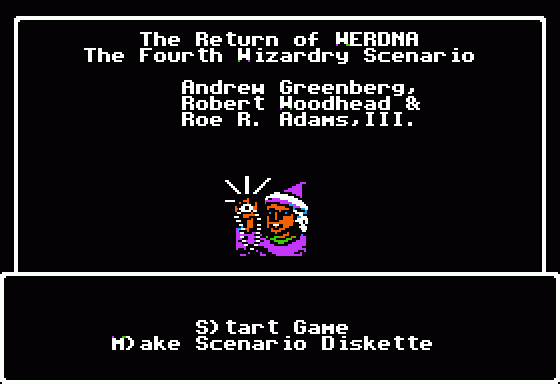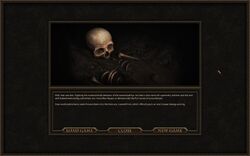RPG Codex Retrospective Interview: Robert Woodhead on Wizardry
RPG Codex Retrospective Interview: Robert Woodhead on Wizardry
Interview - posted by Crooked Bee on Fri 27 April 2012, 20:10:49
Tags: Retrospective Interview; Robert J. Woodhead; Sir-Tech; Wizardry II: The Knight of Diamonds; Wizardry III: Legacy of Llylgamyn; Wizardry IV: The Return of Werdna; Wizardry: Proving Grounds of the Mad OverlordAt the RPG Codex, we have occasionally done interviews in which we asked CRPG developers about their past work. But now we have decided to turn these "retrospective" interviews into a proper (if irregular) series, focusing on seminal titles and designers as well as forgotten gems and unsung heroes.
Robert "Trebor" Woodhead is a legend and a pioneer of the CRPG industry. Together with Andrew "Werdna" Greenberg, he co-created one of the most revered computer role-playing series of all time. The first game in the series, Wizardry: Proving Grounds of the Mad Overlord, was released for Apple II in 1981, becoming one of the first single player CRPGs for personal computers. Robert Woodhead stayed at Sir-Tech until the late 1980s, working on three further Wizardry titles: Knight of Diamonds (1982), Legacy of Llylgamyn (1983), and The Return of Werdna (1987). After that, however, he left Sir-Tech and then -- after spending some years in Japan working on an MMO that remained unreleased -- abandoned video game design completely. In 1989, together with Roe R. Adams, Robert founded AnimEigo, a company specializing in licensing, translating and distributing anime and samurai films, which he runs to this day.
Wizardry was a huge success for Sir-Tech, and it continues to inspire video game designers to this day. For this retrospective interview, we reached out to Robert to ask him a few questions about the 1980s, some of the design and coding decisions behind Wizardry, and the series as a whole.

Prepare yourself for the ultimate in fantasy games! Released in 1981 for Apple II, Wizardry I featured a colorful animated intro.
How does it feel to be the co-creator of one of the most influential video game series of all time? Do you get a lot of fan mail?
How would you describe the atmosphere of working in the video game industry in the beginning of the 1980s, and how did it change over the years that you were active in the industry?
Why did you leave Sir-Tech? Was there some kind of disagreement involved?
How did your decision to leave the industry after you parted ways with Sir-Tech come about? Have you ever thought of going back to designing video games?
Do you keep in touch with any of your ex Sir-Tech colleagues?
Do you still enjoy playing video games, and cRPGs in particular? What is currently your favorite cRPG?

The static title screen of Wizardry II: Knight of Diamonds for Apple II (1982)
You were developing your own cRPG, Paladin, before you joined forces with Andrew Greenberg. What kind of game was Paladin supposed to be?
Prior to your work on Wizardry, you and Andrew were both active on the PLATO network. What motivated you to transform PLATO's multiplayer party-based dungeon crawlers such as Oubliette into a unique single player game?
Did you code the first four Wizardry games by yourself? What programming challenges did you face that you were most proud of overcoming?
Were there any design ideas that you wanted to implement in the series but had to reject because of programming or other technical considerations?

The title screen of Wizardry I for Commodore 64, released in 1987.
The early Wizardry titles were first developed for Apple II and then ported to other platforms. How did you go about this process?
Why did you choose to go for the 20x20 grid dungeons (Might and Magic, for example, later went with 16x16), and why were no dungeons of variable size introduced until Wizardry V?
The ruleset Wizardry used was D&D derivative rather than a faithful implementation of D&D. Was it mainly due to hardware limitations or copyright issues? In particular, why did you not introduce D&D-style spell memorization?
Wizardry's character creation was based on a point buy system with a randomized number of assignable points. Why did you go for such a hybrid system? Did you feel that re-rolling character attributes was an important part of the experience?
In Wizardry I, the player did not even have to explore half of the dungeon levels in order to beat the game. What prompted the decision to leave so many levels unused?

Wizardry III, released on Apple II in 1983, introduced its backstory through an extended graphical slide show.
Who was responsible for the monster design in the early Wizardry titles and who wrote the riddles for Wizardry II and III?
Wizardry III was to a certain extent an experimental title, introducing such ideas as aligment-locked dungeon floors and one-way walls that messed with the geography of levels. Can you tell us a bit about the people who designed Wizardry III (Robert Del Favero, Samuel Pottel and Joshua Mittleman) and how you got to cooperate with them? In a 1983 Computer Gaming World review, they were referred to as WARD, or "Wizardry Research and Development Group." What is the story behind the name?
The WARD group designed Wizardry III, and Roe Adams came up with the idea for Wizardry IV and designed the dungeon levels. To what extent were you and Andrew involved in designing Wizardry III and IV? What were your roles on these two games?
Speaking of Wizardry IV, what were the reasons the game had to be delayed for more than a year?

As if in mockery, Wizardry IV's Apple II title screen introduced the different kinds of do-gooders you will be battling throughout the game.
How did you feel about the rival Ultima series back in the day? Were you keeping an eye on what Richard Garriott was trying to do with Ultima?
Have you played D.W. Bradley’s Wizardries, and if you have, what do you think of them? Design-wise, were you happy with the direction the series took with Wizardry V and, later, VI and VII?
Why do you think the early Wizardry games became so popular in Japan that clones and similar games continue to be released there to this day?
Can you share your favorite anecdote or piece of trivia from the days you were working on the Wizardry series?
To conclude this interview by going back to the way it all began, have you got any advice for college students who want to make their own cRPGs?
We are extremely grateful to Robert Woodhead for taking his time to do this interview!
Robert "Trebor" Woodhead is a legend and a pioneer of the CRPG industry. Together with Andrew "Werdna" Greenberg, he co-created one of the most revered computer role-playing series of all time. The first game in the series, Wizardry: Proving Grounds of the Mad Overlord, was released for Apple II in 1981, becoming one of the first single player CRPGs for personal computers. Robert Woodhead stayed at Sir-Tech until the late 1980s, working on three further Wizardry titles: Knight of Diamonds (1982), Legacy of Llylgamyn (1983), and The Return of Werdna (1987). After that, however, he left Sir-Tech and then -- after spending some years in Japan working on an MMO that remained unreleased -- abandoned video game design completely. In 1989, together with Roe R. Adams, Robert founded AnimEigo, a company specializing in licensing, translating and distributing anime and samurai films, which he runs to this day.
Wizardry was a huge success for Sir-Tech, and it continues to inspire video game designers to this day. For this retrospective interview, we reached out to Robert to ask him a few questions about the 1980s, some of the design and coding decisions behind Wizardry, and the series as a whole.

Prepare yourself for the ultimate in fantasy games! Released in 1981 for Apple II, Wizardry I featured a colorful animated intro.
How does it feel to be the co-creator of one of the most influential video game series of all time? Do you get a lot of fan mail?
I don't feel particularly proud. Wizardry was just one link in a long chain of computer fantasy role-playing games; we were inspired by what other people had done, added a few innovations of our own, and in turn perhaps inspired other creators.
I do get occasional emails from people about the game, which is nice.
I do get occasional emails from people about the game, which is nice.
How would you describe the atmosphere of working in the video game industry in the beginning of the 1980s, and how did it change over the years that you were active in the industry?
In the early days, we were very isolated; the only time we really interacted with other creators was at conferences and conventions. The rate of change during that period was very slow due to the lack of communication -- a 1200 baud modem was the gold standard!
Why did you leave Sir-Tech? Was there some kind of disagreement involved?
I wanted to go in a different direction than my partners.
How did your decision to leave the industry after you parted ways with Sir-Tech come about? Have you ever thought of going back to designing video games?
I actually moved to Japan to build what would have been one of the first MMOs (code-named "Sunday"), in the early 90s, but the project lost funding when Japan's economic bubble burst. But at the same time, AnimEigo grew from a fun weekend project into a real company, so things worked out. And the girl I was chasing after allowed me to catch her.
It might be fun to work on another game, but it would probably have to be in a design role. I still program quite a lot but I'm a lone-wolf coder; I've never worked in a big programming team.
It might be fun to work on another game, but it would probably have to be in a design role. I still program quite a lot but I'm a lone-wolf coder; I've never worked in a big programming team.
Do you keep in touch with any of your ex Sir-Tech colleagues?
No. I am close friends with Andrew Greenberg, though.
Do you still enjoy playing video games, and cRPGs in particular? What is currently your favorite cRPG?
I have been playing EVE Online for some years, and am currently a member of EVE's Council of Stellar Management.

The static title screen of Wizardry II: Knight of Diamonds for Apple II (1982)
You were developing your own cRPG, Paladin, before you joined forces with Andrew Greenberg. What kind of game was Paladin supposed to be?
Paladin would probably have been an old-school dungeon crawler. There was a lot of overlap between it and Andy's original Wizardry game, but each of us contributed ideas that the other hadn't thought of. So Wizardry was a superset of the two.
Prior to your work on Wizardry, you and Andrew were both active on the PLATO network. What motivated you to transform PLATO's multiplayer party-based dungeon crawlers such as Oubliette into a unique single player game?
We were very interested in the question of how much of those games -- which ran on a CDC 6600 supercomputer -- could be crammed into a tiny little Apple II.
Did you code the first four Wizardry games by yourself? What programming challenges did you face that you were most proud of overcoming?
I did the code for the first 4 games. The most interesting hacks I did were the copy-detection system, and the "Window Wizardry" retrofit that added overlapping windows to the UI, which got done from idea to implementation in a single 80-hour coding marathon.
Were there any design ideas that you wanted to implement in the series but had to reject because of programming or other technical considerations?
Not really.
One thing I wanted to do was set up the game so that if it detected it had been copied, and there was a modem attached to the computer, it would wait until it had been idle for a while and then call us up and drop a dime on the pirate. And of course it could be a 900 number... : ) But wiser heads prevailed.
One thing I wanted to do was set up the game so that if it detected it had been copied, and there was a modem attached to the computer, it would wait until it had been idle for a while and then call us up and drop a dime on the pirate. And of course it could be a 900 number... : ) But wiser heads prevailed.

The title screen of Wizardry I for Commodore 64, released in 1987.
The early Wizardry titles were first developed for Apple II and then ported to other platforms. How did you go about this process?
We wrote Apple Pascal p-code interpreters for each target machine. That plus a little assembly language code to abstract the graphics did the trick. We also had a text localization system that moved all the text in the game into a database; it got done for the Japanese localizations and permitted us to create any message we needed on the fly, with all the variable parts inserted into the right places.
Why did you choose to go for the 20x20 grid dungeons (Might and Magic, for example, later went with 16x16), and why were no dungeons of variable size introduced until Wizardry V?
I don't really remember, but it was probably something like 20x20 was the largest size we could do that would fit the dungeon level data structure into 1k. IIRC the Wizardry scenario database packed records for each data type into 1k blocks.
The ruleset Wizardry used was D&D derivative rather than a faithful implementation of D&D. Was it mainly due to hardware limitations or copyright issues? In particular, why did you not introduce D&D-style spell memorization?
We just did what we thought would work best. But some things, like the spell names, were driven by programming decisions; spell name matching was done by hashing to a 15 bit number, which was much more space-efficient.
Wizardry's character creation was based on a point buy system with a randomized number of assignable points. Why did you go for such a hybrid system? Did you feel that re-rolling character attributes was an important part of the experience?
I honestly can't remember, though I'm sure we thought it was a good idea at the time! It may have been related to the way things were done in the Cornell D&D group.
In Wizardry I, the player did not even have to explore half of the dungeon levels in order to beat the game. What prompted the decision to leave so many levels unused?
I think we underestimated how fast people would power-level -- and at the time, nobody knew what power-leveling was. So while there were shortcuts, we expected they would be used only after people had explored all but the final level.

Wizardry III, released on Apple II in 1983, introduced its backstory through an extended graphical slide show.
Who was responsible for the monster design in the early Wizardry titles and who wrote the riddles for Wizardry II and III?
Andrew and his friends at Cornell.
Wizardry III was to a certain extent an experimental title, introducing such ideas as aligment-locked dungeon floors and one-way walls that messed with the geography of levels. Can you tell us a bit about the people who designed Wizardry III (Robert Del Favero, Samuel Pottel and Joshua Mittleman) and how you got to cooperate with them? In a 1983 Computer Gaming World review, they were referred to as WARD, or "Wizardry Research and Development Group." What is the story behind the name?
They were friends of Andrew at Cornell who were the original players of his original Wizardry. But I didn't know them too well.
The WARD group designed Wizardry III, and Roe Adams came up with the idea for Wizardry IV and designed the dungeon levels. To what extent were you and Andrew involved in designing Wizardry III and IV? What were your roles on these two games?
Andy was the lead scenario designer on I-III; he didn't work on IV that much. My role was always writing the code to support what the designers want to do.
Speaking of Wizardry IV, what were the reasons the game had to be delayed for more than a year?
It just took much longer than we thought to get everything working and tested. The joke in the office was that we said "It will be ready next week" for the entire last year, and we really believed it.

As if in mockery, Wizardry IV's Apple II title screen introduced the different kinds of do-gooders you will be battling throughout the game.
How did you feel about the rival Ultima series back in the day? Were you keeping an eye on what Richard Garriott was trying to do with Ultima?
To be honest, I was too busy writing games to play other people's, except for casual arcade games. Ultima was going in a different direction, and that was fine with me.
Have you played D.W. Bradley’s Wizardries, and if you have, what do you think of them? Design-wise, were you happy with the direction the series took with Wizardry V and, later, VI and VII?
I helped David get up to speed on the Wizardry code, and supported him when he made some changes to it for Wizardry V. But I didn't play the later games in the series. When I left Sir-tech, that part of my life was over -- it was time to move on to other things.
Why do you think the early Wizardry games became so popular in Japan that clones and similar games continue to be released there to this day?
I'm pleased, of course, but any explanation I could give would likely be psycho-social bullshit. : )
Can you share your favorite anecdote or piece of trivia from the days you were working on the Wizardry series?
When the industry first got started, all the programmers thought we'd be the rock stars of the '80s, complete with groupies.
Well, it turned out we were right about the groupies. Unfortunately, they all looked just like us -- nerdy guys. : (
Well, it turned out we were right about the groupies. Unfortunately, they all looked just like us -- nerdy guys. : (
To conclude this interview by going back to the way it all began, have you got any advice for college students who want to make their own cRPGs?
Obviously, you'd want to do something for smartphones or tablets, since the barrier to entry and the development costs are much lower there. But mostly I'd give the same advice I give anyone about any project -- do it for yourself, because you love doing it. Money and success is just icing; the cake is the work itself.
Steve Martin said it best when he said that the best thing about comedy was "I get paid for doing this".
Steve Martin said it best when he said that the best thing about comedy was "I get paid for doing this".
We are extremely grateful to Robert Woodhead for taking his time to do this interview!
There are 21 comments on RPG Codex Retrospective Interview: Robert Woodhead on Wizardry














